Welcome to the all-new K’acha Willaykuna (un paso más allá) Newsletter!
K’acha Willaykuna is an interdisciplinary Andean and Amazonian Indigenous Arts and Humanities Collaboration that affirms Ohio State’s commitment to the study of and critical engagement with Indigenous cultures of Abya Yala (the Indigenous denominator for the American continent in its entirety). This initiative is funded through the Global Arts and Humanities Discovery Theme at Ohio State University.
On our website, we describe our name as follows:
In Quechua, art is defined as k’acha willaykuna, “messages with beauty,” which embody meaningfully-made and knowledgeably-made things.
To be more precise, on our website we describe our name in English as above, but we describe it in Quechua as follows:
Quechuapiqa, runap ruwayninqa k’acha willayjinata riqsinchik, “kusiy willaykuna kanku”, ayllu runap ruwayninqa tukuy sunquwan wakichisqa kachkan
Interested in learning Quechua? Find out more at https://u.osu.edu/quechua/
So, what can you expect from our K’acha Willaykuna (un paso más allá) newsletters?
Well, unlike the newsletters we produced during Our Unlearning Hour last Spring, when we collated notes and links from our in-person conversations as we gathered every Friday in the Heirloom Cafe of the Wexner Center for the Arts, the K’acha Willaykuna (un paso más allá) newsletters will offer a broader dissemination potential than just our weekly discussion group.
We want to take a step beyond ourselves and in doing so, we hope to create an opportunity to make a meaningful intervention in current conversations about diversity and inclusion, at our university (Ohio State University) and beyond.

We learned this lesson of ‘going beyond’ from Daniel Bryan and Chel Viteri of the Pachaysana Institute in Ecuador during the first of series of Workshops on Epistemic Justice they presented by with support from K’acha Willaykuna, Center for Latin American Studies (CLAS), and the Department of Spanish and Portuguese.
(For more about the ongoing Workshops with the Pachaysana Institute go here: https://clas.osu.edu/news/virtual-workshop-series-epistemic-justice-presented-pachaysana-institute)
But how will we be ‘going beyond’ diversity and inclusion in these newsletters?
For each newsletter we will ask members of our K’acha Willaykuna community to think about this question and what it means for them, specifically from the perspective of Indigenous Arts and Humanities of the Andean and Amazonian regions, as well as beyond in terms of Global Indigenous Arts and Humanities, Anti-Racism, Social Justice and Decolonial Praxis.
For me (Richard Fletcher aka Minus Plato) going beyond inclusion and diversity in this way means doing two things:
- Stepping out of our comfort zone (e.g. when it comes to questions of language)
- Listening (specifically for moments of connection)
Let me give you an example for each of these processes.
The first is a work at the recent 22nd Biennale of Sydney, curated by Brook Andrew, by Maria Thereza Alves which gives this newsletter its title: OIKOVYTERI ITEKO’A MÔINGUEVYA (Decolonisation continues).
Here is the artist’s description of the project:
OIKOVYTERI ITEKO’A MÔINGUEVYA (Decolonization continues) is the first Guarani newspaper and is made by members of the Juaguapiru Reservation in Mato Grosso do Sul, considered the most violent state against indigenous people in Brazil. The local town of Dourados is aggressively prejudiced against indigenous peoples. Recently on January 3, 2020 police came into the reservation and shot 6 Guarani who defended stolen lands. This newspaper is written to bring to the attention of the general public the deteriorating situation the community is confronting. The editors are Ke´y Rusú Katupyry and Verá Poty Resakã. It is co-published by the Instituto Guarani-Nhandewá de Estudios da Historia do Brasil, Casa da Maria (Maria’s House) and the Sydney Biennale.

What does it mean to bring Indigenous languages (like Guarani and Quechua) directly into theoretical discussions and practical debates about processes of decolonial critique? How does a confrontation with our own ignorance of these languages become a first step in ‘going beyond’ inclusion and diversity as it is typically understood in a university setting? In short, what role does language play in any refiguring of Arts and Humanities into Indigenous Arts and Humanities?

My second example comes from Hispanic-Indigenous Peruvian-American composer, DJ and sound artist Maria Chavez and her recent sound piece called The Rain of Applause commissioned for the AMPLIFY 2020 festival

(which you can listen to by clicking the image above or the link below):
https://amplify2020.bandcamp.com/album/the-rain-of-applause
Chavez’s work is described as follows on the Bandcamp site:
Hyper-memory Installations, or HMI for short, refers to Maria’s specific composing practice with this project, taking audio memories (or .wav files) and layering them in various audibly dense configurations. The composing act of layering audio snapshots multiple times creates a conceptually jam packed day, hence the use of the word “hyper”. By sonically placing multiple tiers of audio documentation, in this case the applause from the Black Lives Matters events, this form of creative field recording practice is aimed to view the sound of applause as a sound source, separating it from the role of applause as a reaction after performance/presentation. As the perception of the listener shifts some may mistake the recordings of applause as sounds from a rainstorm, others may feel the deeper intensity of the applause due to the content the subjects were reacting to.
Here, for me, the question of listening becomes intimately embedded within a praxis of solidarity, making perceptible and tangible shared experiences of racist and colonial violence against Black and Indigenous people across Abya Yala. Put another way, how can our work as K’acha Willaykuna directly and thoughtfully support the Black Lives Matter movement, as well as listen to and with the pain and grief of the present moment, as the shock of the shameless verdict in the case of Breonna Taylor reverberates around us? (Some answer to these questions may arise from the K’acha Willaykuna commission of a Cassandra Press Reader on Erasure – watch this space!)
These two examples (and the questions that unite them) is the basis for two ‘action items’ that I want to publicly propose to our K’acha Willaykuna community. By putting these ‘action items’ here, in the form of this newsletter and not in a series of back-and-forth emails between our members, my hope is that we as a community can be held accountable in a very practical level for our work of inclusion and diversity and how we take a step beyond them.
Action Item #1
Translate the Spanish subtitle of these newsletters (un paso más allá) into an Indigenous language of Abya Yala.
Action Item #2
Use some of our project’s funds to purchase and disseminate copies of Alves’ OIKOVYTERI ITEKO’A MÔINGUEVYA as an explicit act of solidarity with Black Lives Matter and the memory of Breonna Taylor.